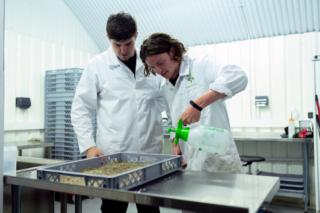
The Science Behind Genetic Manipulation: Why Diversity is Essential
Image Source: Unsplash
As technology advances, genetic manipulation is on the rise. GMOs, selective breeding, and similar scientific practices are becoming more prominent parts of our lives, affecting much of the food we eat. In the average grocery store, 75% of processed foods include genetically engineered ingredients — and it’s rare to find an ear of corn that isn’t modified in some way.
Now, everyday citizens are becoming more active participants in the genome editing conversation. They’re questioning the implications of genetic tampering, whether they be ethical, medical, or even social. But while GMOs may get a bad rap for being unnatural, genetic manipulation has the potential to create a healthier society for all. We’ll explore how this scientific practice can benefit you, directly and indirectly.
Genetic Modification Can Increase Biodiversity
Genetic modifications can increase the number of hybrid species that are fit to survive modern conditions. When genetically modified plants or animals cross-pollinate or cross-breed, new gene combinations arise. Each of these new hybrids picks up genes that help them survive — for example, those that allow them to thrive in warming climates around the globe.
As GMOs make the world’s biodiversity more sustainable, they reduce the risk of our ecosystems and food systems losing key resources. Genetic manipulation can help sustain our ever-growing population in the long term.
Amplifying the Benefits of Plants and Livestock
Historically, genetic modification and selective breeding have helped us create plants that are more beneficial to humans. For example, peaches — which were only 64% edible and earthy-tasting before genetic modification — are now 90% edible, sweeter, and juicier.
Similarly, some plants have actually developed natural bug resistance. People can place mosquito-resistant plants like lavender and mint in their homes to ward off the biting pests, giving them more than one purpose.
Our livestock has undergone similar improvements. For instance, scientists have successfully modified cattle to be born without horns — making inhumane dehorning unnecessary — and produce more meat. GMO cattle may also have less of an environmental impact. Given male characteristics, female cattle can consume less feed (and produce less waste) while bulking up faster, increasing global sustainability.
Increased Yields Boost Accessibility
Genetically modified crops and livestock can be more disease-resistant and produce higher yields than unmodified organisms. When plants and livestock are healthier, farmers won’t have to dispose of as many disease-ridden ones each year, allowing for shorter growth and sales cycles.
With higher yields can come decreased prices for much-needed crops and livestock around the globe. Corn, for example, can now be purchased for $1 or less in the United States. When supply can remain equal to or higher than demand, there won’t be an enormous surcharge on products. Low-income individuals can more easily afford food for their families.
This increased affordability doesn’t just prevent hunger and starvation. It can also prevent malnutrition. For example, scientists have developed a “golden banana” packed with Vitamin A, a deficiency of which can cause blindness and death. This GMO banana can be produced year-round and purchased by consumers at a low cost, helping people in developing countries stay healthy throughout their lives.
Genetically modified seeds and plants could allow people to maintain home-based or community-based gardens, too. The more low-maintenance edible plants become, the more likely people will be able to grow their own food sources and save their hard-earned money. People won’t have to travel to grocery stores to make a healthy meal.
Keep in mind that improving health with GMOs does require gardeners to follow best practices at home. For example, gardeners should purchase newer bags of soils that are formulated to support fast growth and do not contain toxic minerals like vermiculite.
Long-Term Human Health Made Easier
In addition to reducing disease in plants and animals, genetic engineering can help mitigate human susceptibility to disease. Now that scientists better understand the microflora in our gut, for instance, they can create GMO foods that support our gut health and fight harmful bacteria.
On a broader scale, genetic modification has the power to prevent future pandemics, which many scientists have predicted to be on the rise. COVID-19 was a driving force for research on both disease prevention and genetic engineering, and GMOs are a potential solution. One reason why? The degradation of nature is directly linked to viral diseases.
Genetic modification can reduce rates of species extinction and increase biodiversity. This can limit the number of pandemics we face in the future while supporting the sustainability of our world.
Genetic Manipulation Allows for a More Sustainable World
At the rate the human population is rising, genetic modification is needed to save our ecosystems and keep people healthy around the world. Genetic manipulation helps us introduce more beneficial and disease-resistant organisms to our farms, gardens, and beyond. Plus, it’ll help farmers increase their yields, so nutritious ingredients become more accessible. But perhaps the greatest benefit of GMOs is their ability to boost biodiversity and help humans avoid disease, too.
While scientists are still tackling the ethics of genetic engineering, it’s clear that the practice holds an enormous amount of benefits. GMOs may be key to helping all species (including humans) survive in the long run.






